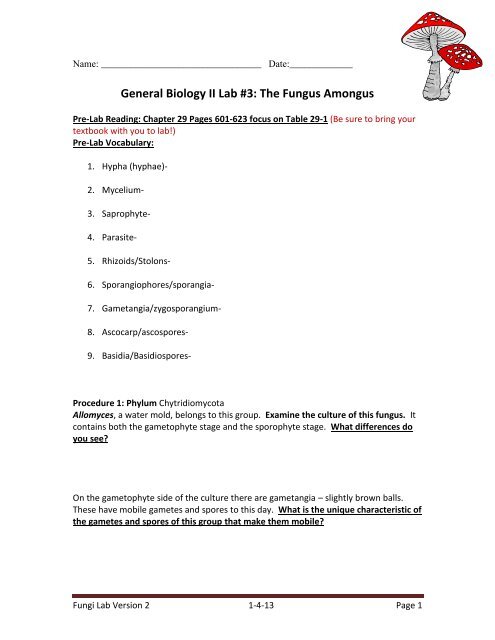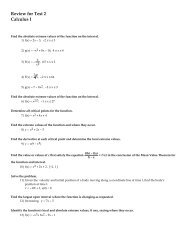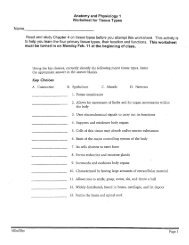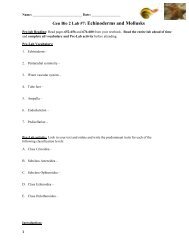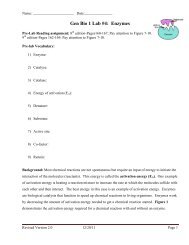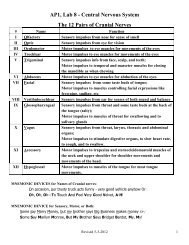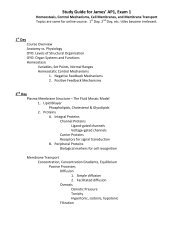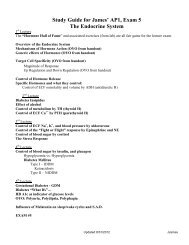General Biology II Lab #3: The Fungus Amongus
General Biology II Lab #3: The Fungus Amongus
General Biology II Lab #3: The Fungus Amongus
Create successful ePaper yourself
Turn your PDF publications into a flip-book with our unique Google optimized e-Paper software.
Name: _________________________________ Date:_____________<br />
<strong>General</strong> <strong>Biology</strong> <strong>II</strong> <strong>Lab</strong> <strong>#3</strong>: <strong>The</strong> <strong>Fungus</strong> <strong>Amongus</strong><br />
Pre-<strong>Lab</strong> Reading: Chapter 29 Pages 601-623 focus on Table 29-1 (Be sure to bring your<br />
textbook with you to lab!)<br />
Pre-<strong>Lab</strong> Vocabulary:<br />
1. Hypha (hyphae)-<br />
2. Mycelium-<br />
3. Saprophyte-<br />
4. Parasite-<br />
5. Rhizoids/Stolons-<br />
6. Sporangiophores/sporangia-<br />
7. Gametangia/zygosporangium-<br />
8. Ascocarp/ascospores-<br />
9. Basidia/Basidiospores-<br />
Procedure 1: Phylum Chytridiomycota<br />
Allomyces, a water mold, belongs to this group. Examine the culture of this fungus. It<br />
contains both the gametophyte stage and the sporophyte stage. What differences do<br />
you see?<br />
On the gametophyte side of the culture there are gametangia – slightly brown balls.<br />
<strong>The</strong>se have mobile gametes and spores to this day. What is the unique characteristic of<br />
the gametes and spores of this group that make them mobile?<br />
Fungi <strong>Lab</strong> Version 2 1-4-13 Page 1
Procedure 2: Phylum Zygomycota<br />
A well-known example from this phylum is Rhizopus, or bread and fruit “mold”<br />
Examine the live Rhizopus stolonifer culture – can you identify the sporangia? Draw<br />
what you see.<br />
Examine the prepared slides of Rhizopus and identify reproductive structures, compare<br />
with Figure 29-9 on page 610 of your text.<br />
Draw and label the following:<br />
Mycelium sporangia<br />
Zygote formation – formed from the fusion of hyphae from 2 different fungi.<br />
Zygospores slide – spores form by meiosis of the zygotes.<br />
Fungi <strong>Lab</strong> Version 2 1-4-13 Page 2
Procedure 3: Phylum Ascomycota – “cup” fungus, yeasts, morels, truffles<br />
An example of Ascomycota is Penicillium. Examine the live culture of Penicillium<br />
notatum and draw what you see. What important medicinal role does Penicillium<br />
play?<br />
Another example of Ascomycota is Aspergillus. Examine the live culture of Aspergillus<br />
niger and draw what you see. What does Aspergillus niger produce that is<br />
commercially important?<br />
Examine the slide of budding yeast, a unicellular Ascomycetes and draw what you see.<br />
Questions:<br />
What is the difference between budding and binary fission?<br />
Fungi <strong>Lab</strong> Version 2 1-4-13 Page 3
What are the other two types of asexual reproduction found in fungi?<br />
Another example of Ascomycetes is Morels. Morels look like mushrooms but belong to<br />
the Ascomycota phylum. Examine the preserved Morel (which is unfortunately a very<br />
small specimen). <strong>The</strong>y can be larger in size, but are typically smaller and more delicate<br />
than common, store-bought mushrooms. <strong>The</strong> small depressions on the surface are<br />
equivalent to a “cup” where the asci are located. <strong>The</strong>y are rare, only occurring briefly in<br />
the northern forests in the early spring, usually around oak trees. Draw a Morel below.<br />
Our last example is the cup fungus Peziza (page 614 in your text). Observe the sample<br />
of Peziza and the slide with a cs. of the cup. Draw and label the asci.<br />
Question:<br />
What type of reproduction is occurring in the asci?<br />
Procedure 4: Phylum Basidiomycota or “Grocery store fungus”<br />
Examine the different types of mushrooms (incl. the gourmet mushrooms) and the gill<br />
w.m. slide. Examine the large Portobello mushroom.<br />
Question:<br />
Where are the reproductive structures, and what are they called?<br />
Fungi <strong>Lab</strong> Version 2 1-4-13 Page 4
Examine jar filled with bracket fungi. Bracket fungi are very tough and can weigh several<br />
hundred pounds. <strong>The</strong>y attach to trees and form a “shelf”. Read the article about the<br />
“giant fungus”. Write two sentences about it.<br />
Procedure 5: Lichens, a mutualistic relationship.<br />
Re-read pages 617-618 in your text for a brief refresher on this unusual relationship.<br />
Examine the different 3 kinds of lichens in the boxes and draw a picture of each one<br />
and label. Also observe the twigs and branches with lichens that were found on<br />
campus.<br />
__________________ ____________________ ___________________<br />
Examine the lichen c.s. slide, which demonstrates intimate relationship between the<br />
alga and fungus that make up lichen. Draw and label the algae and fungus structures.<br />
Fungi <strong>Lab</strong> Version 2 1-4-13 Page 5
Questions to e x p a n d your mind.<br />
1. List and explain several reasons why are fungi so important as to require a whole<br />
lab section just about them?<br />
2. Describe 2 human diseases caused by fungi, including the fungi name, disease,<br />
symptoms, and treatment.<br />
3. Up until this chapter you probably thought a fungus was just another type of<br />
plant. Now that you know the difference, explain the types of relationships that<br />
exist between fungi and plants.<br />
Fungi <strong>Lab</strong> Version 2 1-4-13 Page 6


